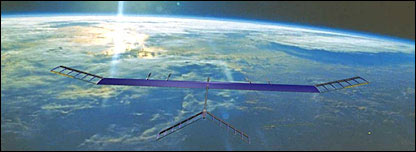UK defence firm Qinetiq, which built the Zephyr unmanned aerial vehicle, said it flew for 54 hours during tests.
The researchers believe it is the first time a solar-powered craft has flown under its own power through two nights.
The previous unmanned endurance record was set in 2001 by a jet-powered US Air Force Global Hawk surveillance aircraft which flew for more than 30 hours.
The Zephyr's 54-hour endurance flight will not enter the record books because representatives from the world air sports federation - the FAI - were not notified about the secretive test.
However, they were informed about a second, 33-hour flight which could still become an official record.
Zephyr's development team say that whatever the result, it believes it has built a record breaker.
"This aeroplane is going to go a lot higher and a lot further," Chris Kelleher, Zephyr's technical director and "pilot", told the BBC News website. "You ain't seen nothing yet."
Night flight
Zephyr was originally developed to take pictures of a giant helium balloon that attempted to break the world altitude record for a manned envelope in 2003.
The attempt was shelved after the Qinetiq 1 balloon sprang a leak.
However, the defence firm has continued to develop the "strato-plane" for military applications, as well as for Earth-observation and communications.
The latest tests took place at the US military White Sands Missile Range in New Mexico.
On the first flight, the aircraft, which has a wingspan of 18m (59ft), flew for more than two days before it developed a fault. The second, shorter flight was curtailed when thunderstorms threatened the propeller-driven plane.
"What was proved - and what was a world first - was that the aircraft was flown using its solar electrical power system through two complete diurnal cycles," said Paul Davey, Zephyr's business development director.
"The aircraft was flown on solar power and charged its batteries during the day, discharged its batteries during the night, and remained aloft the following dawn when the cycle was repeated."
During the flights, Zephyr reached a maximum altitude of more than 58,000ft (18,000m).
Record bid
The plane is launched by hand and is flown manually to 10,000ft.
"On the ground we have all of the instrumentation a pilot would see on a manned plane," explained Mr Kelleher.
Although, the first flight was more than 20 hours longer than the current record, it will not enter the record books. The Qinetiq team did not pre-notify the FAI (Federation Aeronautique Internationale) of its first flight, a requirement of an official world record.
And, although they did notify the body of the second flight, no FAI official was present to oversee it. "The record attempt was announced very late," said an FAI spokesperson.
However, the Qinetiq team believes that air traffic controllers at the White Sands base will verify the 33-hour, 43-minute flight, which took place on the 31 August.
The FAI spokesperson said the organisation was waiting for details of the tests to be submitted.
Planetary explorer
Zephyr is not the first solar-powered plane to fly through the night.
A craft called SoLong, developed by US firm AC propulsion, flew for 48 hours in 2005.
However, unlike Zephyr, the craft was not under constant power for the duration of the flight. Instead, it occasionally had to glide or soar.
Other companies and organisations have also developed similar craft.
The US space agency Nasa developed both the Pathfinder and Helios vehicles.
The agency believed the vehicles could one day be used as a replacement for satellites or as unmanned drones to explore other planets such as Mars.
Helios, the successor of Pathfinder, set an altitude record in 2001 for a non-rocket-powered winged aircraft when it climbed to 96,863 feet (29.5km).
But in 2003, the vehicle broke up on a flight from the US Navy's Pacific Missile Range Facility on the Hawaiian island of Kauai.
Fragile cargo
Others currently building solar-powered planes include Switzerland's ETH.
Its experimental Sky-Sailor craft is much smaller than Zephyr, with a wingspan of just 3.2m (10ft), and is designed for use on Mars.
All of these prototype vehicles have flown autonomously or controlled by a pilot on the ground.
But in 2010, Swiss balloonist Bertrand Piccard plans to launch Solar Impulse, a manned plane in which he will attempt to circumnavigate the globe.
To carry the precious payload, the craft will have a huge wingspan of 80m (262ft), wider than the wings of the Airbus A380.
As the plane is piloted by only one person at a time, it will have to make frequent stopovers. The current plan is for the journey to be broken into five legs each lasting between four or five days. .

